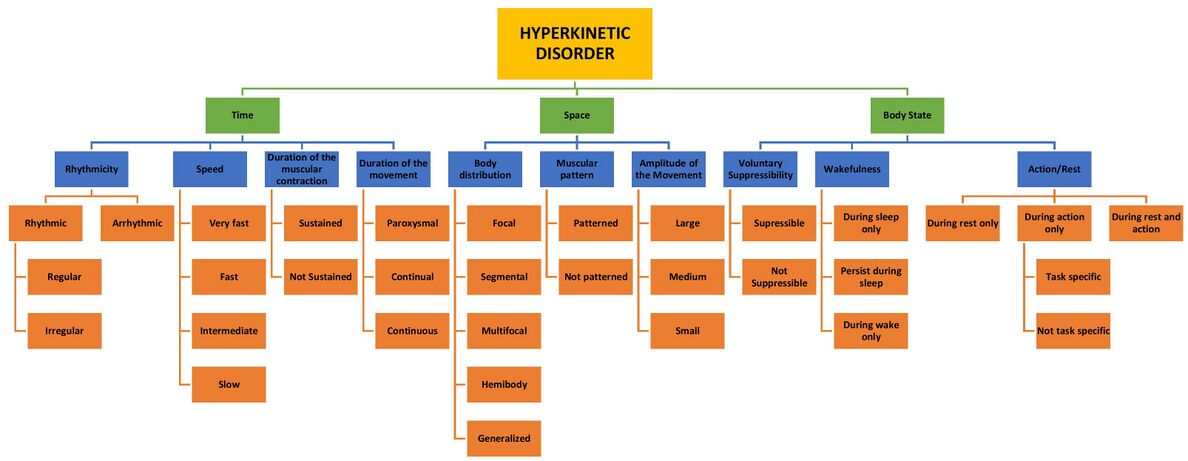Hyperkinetic Movement Disorder
Introduction[edit | edit source]
Hyperkinetic movement disorders also referred to as Dyskinesias are characterized by abnormal, often repetitive, involuntary movements overlapped to normal motor activity. Its 5 major types are Tremors, Chorea, Dystonia, Myoclonus and Tics.
Etiology[edit | edit source]
Common etiologies seen in Hyperkinetic Movement Disorders-
- Genetic abnormalities
- Neurodegenerative diseases
- Structural lesions
- Infection
- Drugs
- Psychogenic problems
- Others
Pathophysiology[edit | edit source]
Among all HMDs there appears to be decreased neural firing rates in the inhibitory output nuclei of the basal ganglia leading to a subsequent disinhibition of thalamocortical activity. Sensory abnormalities may also have a role.
Cardinal Features[edit | edit source]
Hyperkinetic movement disorders can be grouped according to distinct cardinal features, which can be described in terms of
- Time
- Space distribution
- Body state’s impact.
Rhythmicity
A rhythmic movement repeats over time at a fixed interval of time. If the movement can be defined with a frequency during an observation period, it has a regular rhythm (e.g., essential tremor, parkinsonian tremor), if the movement repeats with a more complex temporal pattern, it has an irregular rhythm (e.g., cortical myoclonus), and finally, if the movement repeats over time at no fixed interval of time, it is arrhythmic (e.g., chorea, athetosis, ballism, tics, akathitic movements).
Speed
The second temporal item is the speed of the movement . It can be very fast, such as in myoclonus or hemifacial spasm, fast las in ballism or tics, intermediate as in chorea and tremors, or slow as in athetosis or akathitic movements.
Duration of the Muscular Contraction
Finally, in terms of the time spectrum, we need to describe the duration of the muscular contraction and the duration of the whole movement . The duration of the muscular contraction can be sustained or not. A sustained muscular contraction is fixed and doesn’t change during time, unlike the non-sustained muscular contraction.
Duration of the Movement
The duration of the movement can be defined as paroxysmal, if the movement repeats with a sudden recurrence (e.g., paroxysmal dyskinesia, paroxysmal ataxia); continual, if the movement repeats over and over again without a sudden recurrence (e.g., ballism, chorea), or continuous, if the movement continues without stopping (e.g., abdominal dyskinesias).
Body Distribution
According to space characteristics, we can classify hyperkinetic movements according to body distribution, i.e., the body part involved in the involuntary movement. Dystonia can be classified as :
- Focal: 1 body part is affected
- Segmental: 2 contiguous body parts are affected
- Multifocal: 2 non-contiguous body parts are affected
- Hemi -dystonia: Ipsilateral arm and leg are involved
- Generalized: 3 body parts are affected, including the trunk and �2 other sites; with or without leg involvement
Below is Chart representing Cardinal features of hyperkinetic disorder in detail.
Classification[edit | edit source]
There are 5 types of tremors
Assessment[edit | edit source]
Things that are need to be assessed
- Gait and Balance for fall prevention
- Functional tasks
- Speech and cognition
- Dysphagia
- Mental Health (behavior/affective state)







